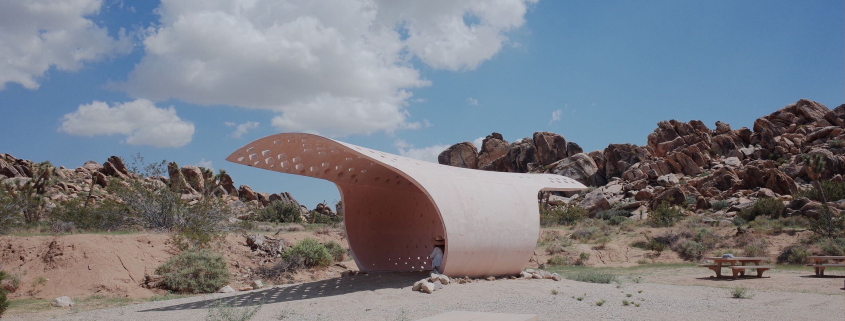Architecture project placed in Joshua Tree National Park

Joshua Tree National Park may not seem like an ideal place for undergraduate architecture students to design and install a building, but to Douglas Noble, an associate professor of architecture at the USC School of Architecture, the difficult environment of Joshua Tree poses the perfect challenge for some of the design projects of fourth-year architecture students.
“Joshua Tree is a unique location for architecture students to study because the climate is very difficult,” Noble said. “So when we ask fourth-year undergraduate architecture students to design a building for Joshua Tree, they’re faced with enormous challenges … where would they put the building? There’s no electricity, there’s no water. There’s no help of any kind.”
Now, as the result of years of tireless work and effort, USC architecture students have installed a shade structure called the Carapace Pavilion in the park — with the team receiving multiple industry awards for their work.
“Before they graduated, our students had an award hanging on the wall that many professional architects never get. So, all the students who worked on that original design team have an AIA design award on their wall, and that’s not a student award … at the event we were given our award for this little tiny project, and the next award-winning project was SoFi stadium,” Noble said.
The partnership between the USC School of Architecture and Joshua Tree began a decade ago. Noble, passionate about national parks and motivated to do some sort of project with his students involving one, came into contact with the superintendent of Joshua Tree National Park, Mark Butler, who happened to be a USC alumnus.
“He was pretty enthusiastic about working with us and making the Trojan connection, and that’s how we got started,” Noble said.
Students worked with Noble and other faculty for several years on projects for the national park until 2019, when the project that would later become the Carapace Pavilion began.
Michael Gonzales, a USC alumnus, became involved in the Carapace Pavilion when he was a senior in 2019. He said that the initial design for the structure came about through the collaborative efforts of the students who had enrolled in Noble’s topic studio class.
“Professor Noble made a criteria for us, which had certain parameters based on actual rules from the National Park,” Gonzales said. “So collectively, we would make a design, and then, based on the checklists and parameters that we were designing within, we would see whose design hit all those markers. So some obviously hit it better than others or some couldn’t hit those parameters, but we used a lot of those rules to help guide our design.”
Ivan Wong, a 1st year master’s student studying science in product innovation who also became involved in the 2019 project, discussed the collaborative environment, with students participating in every stage and aspect of the project.
“When the studio started, everyone kind of did everything in terms of design and talking through how we’re going to build this thing … I feel like everyone in that studio did so much,” Wong said.
Among several technical challenges, the biggest obstacle the Carapace Pavilion team faced was the coronavirus pandemic; Victoria Dam, a USC alumna, discussed how the pandemic stunted the project.
“When we were starting to get into a good momentum, the pandemic happened, and because of the University rules, we were [considered] students, and students were not allowed to work on the project,” she said. “So that delayed our schedule quite a bit.”
Although students were not allowed to work on the project during the pandemic, Noble maintained some progress by working with alumni and faculty. Eventually the team completed and installed Carapace Pavillion in Joshua Tree in October of this year — holding a special significance to the students who spent the last three years working for the project to become a reality.
“It feels like the work was worth it, just seeing it installed. I think the awards were really cool and surprising, too,” Wong said.

